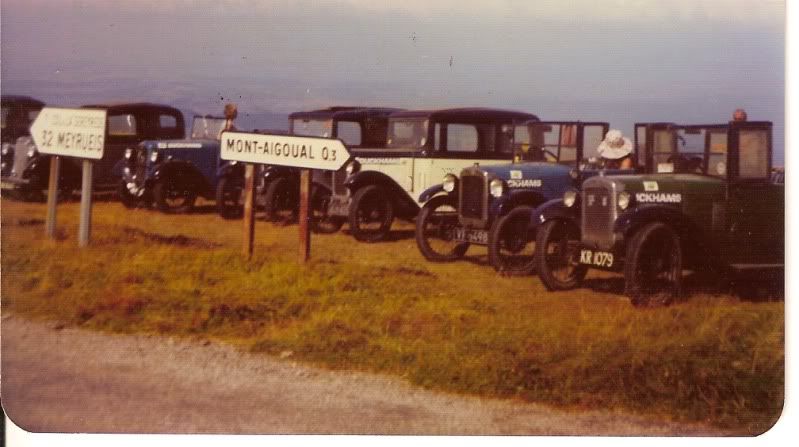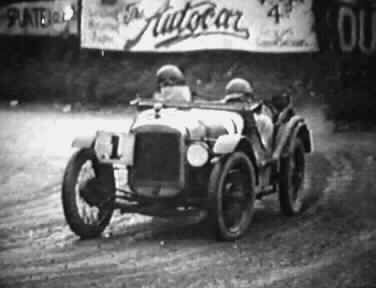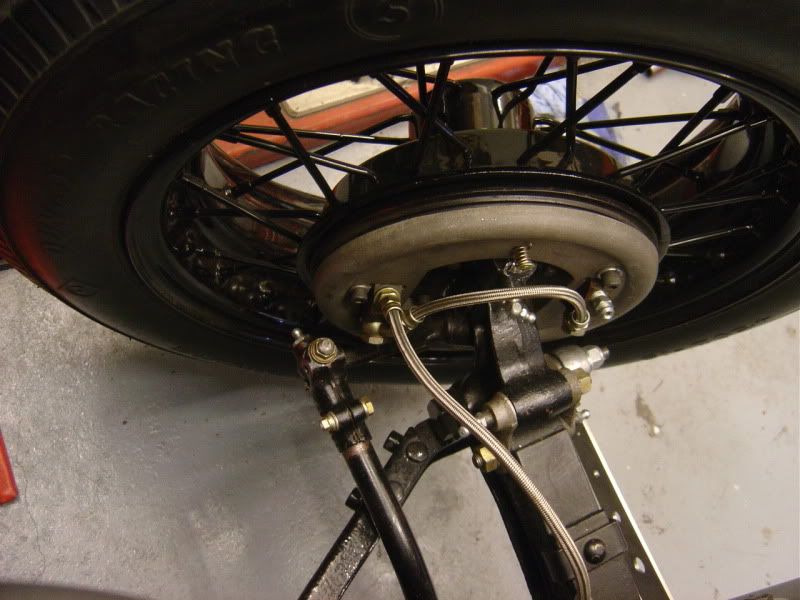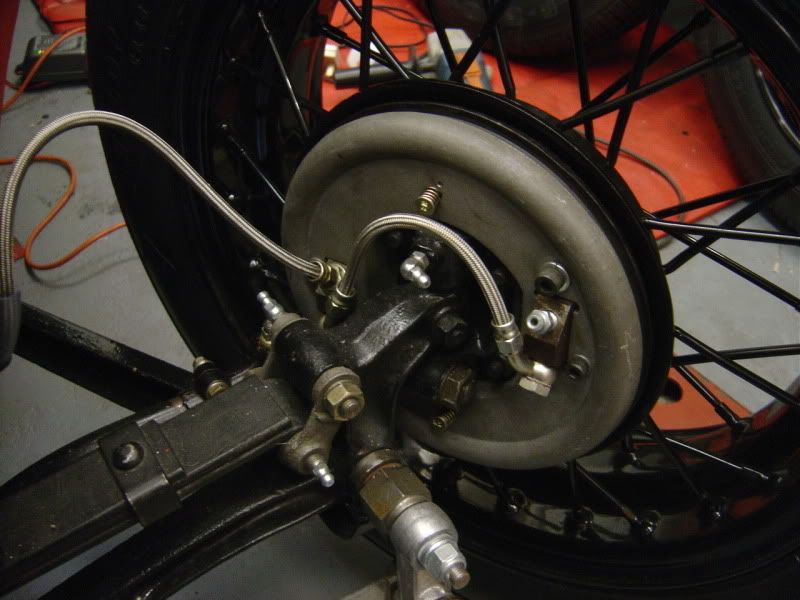
Welcome to the Austin Seven Friends web site and forum
As announced earlier, this forum with it's respective web address will go offline within the next days!
Please follow the link to our new forum
http://www.austinsevenfriends.co.uk/forum
and make sure, you readjust your link button to the new address!
Can those owners who have a modified car with hydraulic braking system kindly advise on the route their pipework takes at the front of the car - I will be plumbing my brakes in on my 1934 Mk I Ruby shortly and this could be undertaken in several ways and rather than "reinventing the wheel" it is useful to know what others have done in the past.
Thanks in anticipation - photos could be useful!
Regards
Gary
Location: Saltdean, Brighton
Hydraulic brakes? Where's the fun in that!
Seriously though, I had hydraulics on my Ruby based Super Accessories Super Sportsman (DXX 401, where are you!)and I have some pix somewhere that may help, I'll have a dig around tonight.
Location: Near Bicester
My '34 Opal had hydraulic brakes when I bought it, which I thought a good point until I came to remove the back axle...
The master cylinder is beside the starter motor, and the stop light switch just in front, bolted to the wing support. Two pipes go to the two flexible hoses which are attached to two brackets also bolted to the wing support. The off-side pipe is tucked in behind the number plate.



Alan
Location: Colwyn Bay
Gary you are welcome to come and see the set up steve did on my racer.
Ben BRIGHTON
Thanks Alan for the photographs, that is useful, particularly for the flexible hoses, seeing these at the front to avoid all the steering gear at the rear! Thanks for your trouble.
Regards
Gary
Location: Saltdean, Brighton
Hello Ben, thanks for the offer, I would like to take you up on this, I will private e-mail you, thanks, Gary
Location: Saltdean, Brighton
Just to bring matters up-to-date, progress has been slow on the car - laterly as it has been so cold I've not had the inclination to go out in the garage!
I am fitting an hydraulic kit from an A7 supplier, all the parts have been pre-assembled onto the back-plates - wheel cylinders, shoes & springs, so it is just a case of installation onto stub axles.
I have fitted the new back-plates (as I think they should be so that these fit for the hydraulic connections) and in this position, it gives twin trailing shoes, which I am not overly happy about, since clearly sound braking practice is for a twin leading shoe layout. This is also referred to on the guidance notes for the 1950's conversions, so I cannot see why a twin leading shoe is not possible?
If the back-plates are reversed, to the opposite sides to give a twin leading shoe layout, the hydraulic connections to the lower point of a wheel cyclinder is impossible to undertake. Any connection is prevented by the position of the steering arm - no way that this can be made! Set-up as trailing shoes, the hydraulic connections fall naturally to hand for a decent layout for the pipework.
The photos posted in a reply made above, show twin leading shoes, but on the Speedex Website, the picture of the installation show twin trailing shoes. Confusing!
Am I being over sensitive, for example, the lightness of the car mean that it will not make any (much) difference, or have I been supplied with back-plates that have been incorrectly fitted with wheel cylinders and these need to be removed and re-fitted in different positions - I am loath to undertake an alteration myself - firstly, as I paid for these and don't see why I should end up with lots of holes in the nice new back-plates and secondly, I will be modifying a part which has been supplied as part of a kit and I would have to declare to the Insurer that I have undertaken an alteration and I don't want any queries on that!
So, any owners with either set-up on their hydraulic systems could kindly shed some light on this before I proceed further, photos are attached showing the back-plates in position on the NSF to illustrate my query.
The rears are set up correctly, so no problem there!
Thanks
Gary

NSF - twin trailing set-up

NSF - twin trailing set-up - connections all fall neatly to hand

NSF - twin leading shoe set-up

NSF - twin leading shoe set-up - impossible to get a connection - the yellow bung is held in place by the steering arm!
Location: Saltdean, Brighton
Hi Gary,
your very last photo (Twin Leading Setup) is the same that I have on my car.
The pipe is very difficult to get in but with a "very" tight bend, it will just fit in, you have to remove the cylinder slightly, tighten up the union and then replace it. It doesn't look pretty and loops upover the top of the stub axle.
I have the reverse setup for the pipe and bleed nipple to you, the nipple is at the front, easier to bleed, "if" you have enough length on the rubber pipe to reverse them.
You are welcome to phone me on 0141 942 8037 for further information if needed.
Good luck,
Ruairidh
I also have the opposite pipework,if you have access to a lathe and making the pipes up,it is possible to shorten the nut down,and coning out the bore to allow a better tight bend around the track control arm.
The previous owner who converted my car simply didn't bother with a bleed nipple. This has caused obvious problems, and is on my 'to do' list, though I have managed to bleed by slackening the union.
Alan
Location: Colwyn Bay
The set up shown below has now been on this car for over 50 years and may be of help.
1st picture shows the pipe work which goes through the flitch plates on this car, hides them a little better in my opinion.
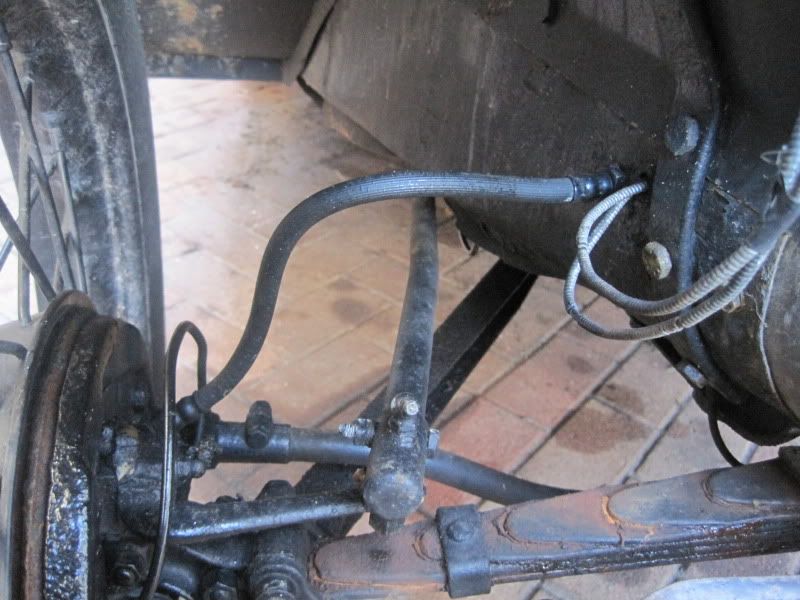
This is o.s setup followed by a close up of the "problem" area"...
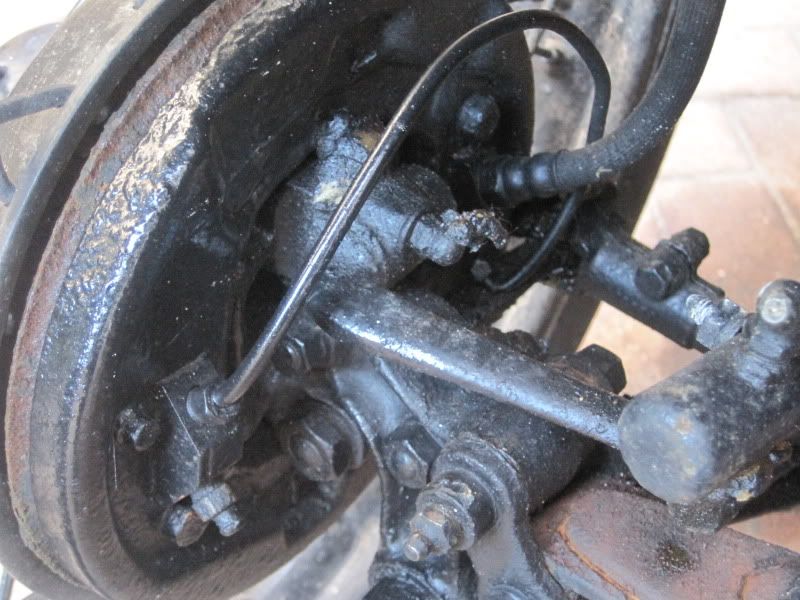

Next two are of the n/s setup with close up....
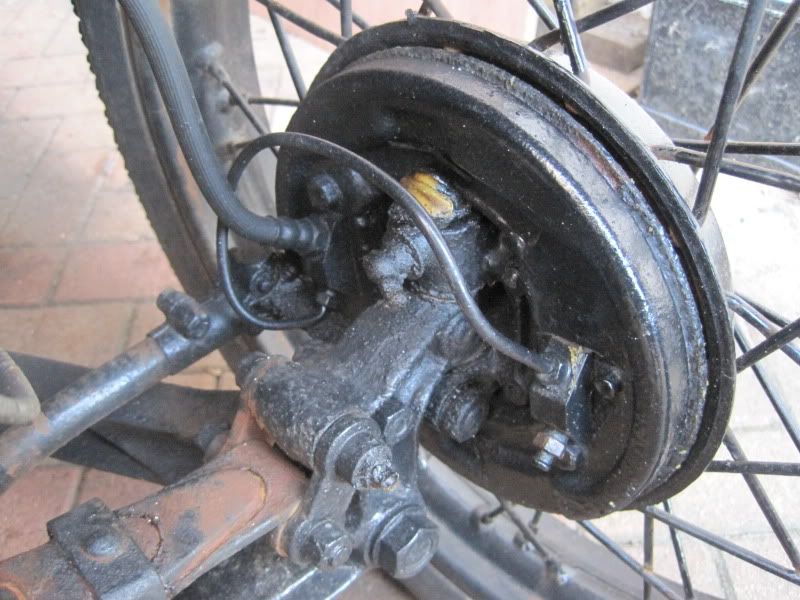
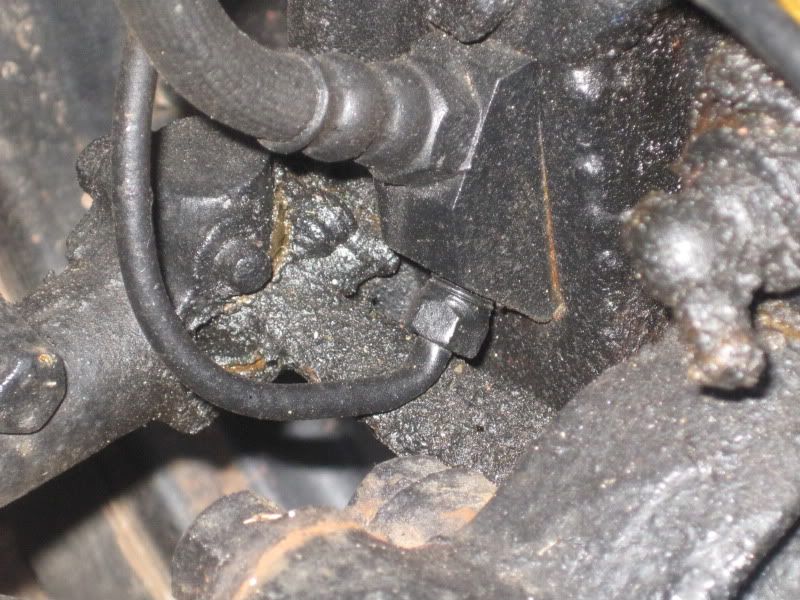
When I last overhauled the system which involved all pipe work being replaced, all new cylinders and a new master cylinder I also fitted silicon brake fluid see brake fluid which has the advantage of being waterproof so the likelihood of seized cylinders should be a thing of the past. The car spends a lot of it's life outside and in the five years since overhaul has not suffered so well worth the extra expense in my experience.
Hope this is of help.
Cheers
R
I'm not an afficionado on A7 hydraulic conversions,and I can see why the set-up leads you to go for a trailing shoe arrangement due to the conflict with the front suspension parts. Nevertheless I would caution anyone with such a conversion that still has twin TRAILING shoes that it's intrinsically inefficient, and is probably illegal. A leading shoe has a "self-servo" effect whereby the rotation of the drum tends to pull the brake shoe on harder thus improving the braking effort. A trailing shoe does the opposite. On cars with drum brakes, normally the rear drums are trailing/trailing in order to give a self-servo effect when reversing. However, front brakes should have at least one and preferable both shoes 'leading' in order to get the best out of the system.
Any vehicle examiner worth his salt would immediately condemn a trailing/trailing shoe set up on a front axle as unroadworthy. (notwithstanding that the necessary percentage braking efficiency might well be achievable)
If you're going to go to all this effort, you might as well do it right...
Location: South of France, but it's still wet & cold.
Hi Reckers,
I've read what you say and it makes sense to me, do you therefore consider that the setup on my car is incorrect - this could account for the contant "tweaking" I have to do to kepp them up to scratch. Any thoughts gratefully accepted.
Cheers
R
If you're telling me that your car is set up as twin trailing front, then I'd seriously advise you to make the effort to change it. You will notice a huge improvement in the braking efficiency AND you'll not have to stand on the pedal as much to get it to stop.
As a former vehicle examiner I am a little uncomfortable also with the appearance of the tight bends on your hydraulic link pipes, where they exit the cylinder. The bend is not uniform and it looks like the tubing could well be trapped, or at least the X section reduced - that could affect the balance of pressure distributed to each cylinder.
I bet it brakes well going backwards though!
Location: South of the 45th parallel but you'd never realise it
Thanks everybody for your input and it has confirmed my thoughts that a twin trailing shoe set-up is not the way forward (even though this gives the best space for connections).
I think the space between the wheel cylinder & the steering arm is less than you have on your car (Ruairidh's photos), but looking at your pictures again, Ruairidh, the fixing bolts to the wheel cylinders are orientated in the same way as my first picture, which is for the twin trailing shoe set-up, so perhaps your system is thus and not twin leading?
I would be interested to know if that was the case and I would appreciate any trouble to confirm this as a matter of fact - bearing in mind your brakes have been in service for 50 years something must be working right!
In terms of the flexible hose & bleed nipple, these are not fitted, just screwed in to illustrate where they might go, so no constraints here!
In view of RR's comments, in view of the almost zero space, I am now wondering if the connection above the steering arm is best blanked off (as a minimum a bleed nipple could be fixed in position and cut off flush) and the uppermost connection fitted with an adapter (the same as the rears) to enable a flexible hose to be fitted and the bridge pipe to the front. The only drawback I can see with the pipework in this orientation is that the flow of brake fluid for bleeding purposes could trap air (but that would be the case on the rears anyway), and this might be the way to go with careful bleeding.
BTW, the rears are one leading & one trailing.
I was thinking about silicone brake fluid and agree that this is worthwhile to fit.
Thanks again, and any further comments gratefully received.
Gary
Location: Saltdean, Brighton - sunny today!
Reckers,
I'm very glad that I posted the picture, it is twin trailing (sorry to give you a bum steer on that one Gary) and I will do my best to try and rectify it, I agree with the comments about the pipes but its the only way it would fit but I will look carefully at how it can be improved. They do work, very well in fact, but I do have to constantly adjust the snail cams to keep it working.
Interestingly I was thinking along the same lines as Gary as to how to overcome this, that of using one of the rear-type extension bleed nipples, need to look carefully at this but intend to do it soon so will post back.
Many thanks,
R
p.s. Reckers, my father has sent me a picture to upload for you, will attend to this just now.
Sorry there's a typo on one of my earlier posts - A7 rears are trailing/leading and not trailing trailing as typed (OOps!)
Ruairidh, I just found this whilst having a surf - whilst you may find that your brakes are OK, swapping them to twin leading shoe should show a marked improvement in efficiency:
Some brakes have two wheel cylinders, with one piston in each cylinder. When the brakes are applied, hydraulic pressure forces each piston to move outwards, pushing on one end of the brake shoe. The direction of rotation of the drum produces a wedging action on both brake shoes, so they are both called leading shoes.
This system was once popular on front wheels because it is very efficient in the forward direction. This is due to the self-energizing or self-wedging action of the shoes as the drum rotates. Its main disadvantage is that it is only about 30% as efficient in reverse, so it is usually combined with a single leading shoe arrangement on the rear to provide a balanced system.
Can you not rotate the backplates 90 degrees? Then the inlet could be at the bottom and the bleed at the top. I guess there is a reason why not because else someone would have done it by now!
Steve
edit
I see that the bottom one may foul on the axle? I'm just thinking out loud! I've never seen it in real life!
Nice idea Steve, and would most probably work but my backplates can only be rotated 180 degrees, unlike the girling ones which are circular.
Cheers
R
On the same subject....sort of...
Motorbikes used cable operated twin leading shoes. It seems quite simple when you look at a motorcycle front brake. Has anyone ever done this on a Seven instead of hydraulics? I seem to remember a discussion like this some time ago when I was setting up my Girlings, regarding floating shoes etc but my memory is not that good.
Steve
Steve, I think the system you may be thinking of is the Bowdenex conversion.Apparently works with great effect and has been used many times by austin seven owners for many years,
cheers Ian.
Location: wet murky Worksop
Have struggled to get Photobucket to obey me and show you this but below is the best I can manage. Anyway, here's my solution. How I dislike hydraulics! And Photobucket!
PS the bleed nipple has a cover on it.
http://i179.photobucket.com/albums/w283/stuartu/2011_0108diabolical0001.jpg
Regards, Stuart
Stuart,
that's perfect, exactly what was going through my head when I was trying to work out how to overcome it this afternoon, very useful.
How did you block the bottom part of the slave cylinder that the rubber pipe goes into?
Cheers
R
Well at least you could see the picture, R.
Answer: with an Allen headed grubscrew pressing on an appropriately sized ball bearing.
Regards, S.
There was another discussion a year or so ago around converting cable to run as Twin Leading Shoe. This could use a motorcycle type way of doing it with the outer cable on one leg and the inner cable on the other leg. The harder part is converting to twin leading show. Involves creating a new cam at the top, with a new pice bolted onto the back plate.
There was a very smart setup by Bernard. I am not sure if he still reads this - or if he got his car finished?
Jack French had some designs in the 50's as well.
Peter
Just seen the picture posted by Stuart, that is also along the lines I have been thinking about this afternoon and unless the steering arm is re-designed I cannot see how twin leading shoes can possibly fit. The back-plates can only be rotated 180-degrees and I guess that the wheel cylinder position has been determined to give the required space for the adjustment mechanism.
Alan's set-up is along similar lines, but on his car he has not got any bleed nipples! So, it looks like this has been a problem for a considerable time, interesting that there has been very little comment that I have seen.
Ruairidh - many thanks for the confirmation about your installation, although, I cannot see that the adjustment of the snail cam would make any difference if it were trailing or leading. Thinking about it logically, the rate of wear of the brake linings should be the same no matter which way the drum is rotating, the difference between trailing and leading is the effort required and the efficiency of that effort, but no matter what system there is, the contact of the brake lining is what stops the rotation and it will not care how or where that comes from! So unless your snails are worn so that they slacken off???
Reckless Rat - on the conversion I am undertaking - you can see on my photos at the top of this post, the two wheel cyclinders that have been fitted to the back-plate in the manner you describe.
From my reading around the subject it seems like it was the late 1930's that the leading shoe arrangement was first introduced - an edition of Practical Motorist dating from 1939 explains the set-up to readers and they say it has a 30% improvement over previous arrangements (probably leading/trailing).
Well, having seen the set-up on Stuart's car, I think that arrangement with the lower connection blanked off is the best way to go.
It would be interesting to know how many cars have been set-up with twin trailing shoes.
Thanks everybody for their input - it does show how useful this Forum is at sharing ideas to mutual benefit - modern technology can sometimes be useful!
Gary
Location: Saltdean, Brighton
My comments regarding the set up were meant to be for Ruairidh whose arrangement is probably trailing/trailing. However, Ruairidh - take one of the hubs off to make sure! If you take off the nearside wheel & hub, the front cylinder should be acting on the bottom brake shoe and the rear one on the upper shoe (so they open in the direction of rotation)
Gary, I can see your intention is to go the right way.
However, having seen your set up and the suggestions regarding a blanking plug for the rear cylinders I would opt for an arrangement similar to Stuart's. It's important that the brakes can be properly purged, so you need a bleed nipple on each hub (on the other cylinder to where the flexible is mounted), but also you need to ensure that there is no obstruction/stress to the modification when placing the wheels on full lock - be careful regarding the location and securing of your flexible hoses so there is no over stretching/excessive bending of the flexibles, and of course that they can cater for full bump & rebound of the suspension.
It looks like a nice job. I hope you manage to sort it all out. Good Luck.
Location: Downhill from that place on Ian Dunford's photo
Gary,
FYI, I found the Morris 1000 springs not sufficiently strong to be effective and changed to A7 Semi Girling ones which worked much better and are easily available. The snail cams could well be worn, I'll check them also.
Reckers,
I will check the internals, but I am certain it is wrong from what you have said. My father and I think that is has been like this since he purchased in in 1964! We believe the conversion was done in the late 1950's...
Stuart's design looks good and that will be my first move once I have located the correct banjo union.
Thanks again.
In my humble opinion one of the most valuable technical discussions in a while.
Thank you Gary for your initial question and clear pictures.
This has revealed a very serious problem with what appears to be a readliy available conversion. Although I would not use this (being a sad vintage car traditionalist) I can see the attraction.
Thank you for the expert evaluation of leading versus trailing shoes and confirmation of the need for leading (or at least leading and trailing) shoes on front brakes.
This brilliant evaluation and solution would have been very difficult without the forum, shown by the continuing use of incorrect assemblies over many years. I would hope that the producers of this conversion are advised of the difficulties and and methods needed for the correct assembly.
Tony.
Location: Melbourne, Australia.
Whilst I of course accept that all the above details of the dangers of the trailing shoe situation are undoubtably correct ,I have to point out that the actual result in driving around for 46 years,in this parlous condition(only means of transport until 1970,and well over a quarter of a million miles in total)I have never actually run into anyone myself,but I did on two occasions manage to lose-weigh rapidly enough collect two rear-enders I have however had a few exhilarating moments on trying to turn around on 1in3 hills(having lost forward motion for some inexplicable reason), to find that going rapdlly back down towards sea-level,in reverse the brakes do not actvate without vigorous pumping. I should have looked into this decades ago.
Location: Frampton Cotterell
Ruairidh,The components required should be as per standard morris minor rear brake set up(eg banjo, bolt and bleed nipple) all are readily available from any minor specialist.
Cheers Ian
Location: At work in sheffield
This is an old problem, I remember seeing quite a few hydraulic braked Sevens at Beaulieu in the 60s and their answer to the problem was to fit the track rod in front of the axle. I don't care to think what it did to the steering, but the Ackerman principle was probably lost.
One of our Sevens was twin trailing shoe when we got it in the sixties and it worked well however I wasn't happy with the basic principle and changed it to twin leading shoe. I removed the nipple end from the bleed screw flush to the hexagon to get clearance with the track rod arm. To bleed the system I removed the track rod and arms and push a small diameter hose into the nipple and use an Easi Bleed one man bleed system so there is no risk of drawing arm back in. After all that there wasn't a great improvement in braking with twin leading shoe. That particular car has since been converted back to cable brakes because with the linings that are now available from our suppliers they are as good as hydraulic. The hydraulic conversion remedied the problem of useless brake linings that were available in the 60s
Another problem I found was on fitting a spare rebuilt track rod assembly to the car was it wouldn't fit because one of the arms fouled the bleed screw-the track rod arm was bent.
If you need stronger brake shoe return springs Ruairdh it suggests that you have a master cylinder for disc braked Morris Minor which has a pressure sustaining valve in it.
Location: Stockport
Dave, I knew I should have stayed in bed this morning!
When recomissioning this car 5/6 years ago, as a suprise for my parents (they went to Norway on their Honeymoon in this car), my gut reaction was to return the braking system to it's original uncoupled system (which I do know, understand and trust). However, I decided to replace what was there, at great cost, ah well...one step closer to getting it right...maybe?
Ian B, many thanks, I had thought this also and will investigate.
Ian D, do you want it back, not sure I can get Willow and twins in the back?
It's snowing up here again!
Ian
Thanks, I am familiar with the Bowden type cable brakes, it was the twin leading shoe bit that interested me! .
.
pgs, fantastic pictures, that has trigered my memory a bit now and I seem to remember more of the previous thread now!
Re the track rod facing forward to give clearance , I have seen several racers which do this so maybe the obvious effect on the Ackermann geometry is not that noticable with narrow tyres? This would solve the problem.
The stub axles in the pics look like Girling ones? If so could a backplate arrangement allowing the fitment of cylinders top and bottom be arranged or is there not enough room to do this? I take the point that the current set ups only allow movement of 180 degrees.
Steve
Steve,
"Re the track rod facing forward to give clearance , I have seen several racers which do this so maybe the obvious effect on the Ackermann geometry is not that noticable with narrow tyres? This would solve the problem."
I would have thought that putting the track rod arms in from the front would have compounded the problem causing 'toe in' on cornering. Or is there enough room to reverse them side for side with a lengthened track rod?
Or perhaps, as with the twin trailing brake shoes on the front, the non Ackerman effect doesn't really matter.
Tony.
Location: Melbourne, Australia.
Some 40 years ago I was offered a kit of hydraulic conversion parts from the chap up the road who had just scrapped his special! I had to do all sorts of inventing to fit them into my Box Saloon and ran into the problem of the interference with the track rod as shown in Gary's picture on 6 January. As suggested earlier the solution was to use a pipe nipple to trap a small ball bearing on the cone face of the fittings. This has served me well since then. The track rod is tapped out whenever there is a need to bleed the brakes.
Ron
Location: Thornbury S Glos
Gary,Anothere solution to the problem of the arms fouling the bleed nipple would be to heat the arms up and put a dog leg in them sufficient enough to clear the niple as per a dropped front axle setup.I`ve done this on the RTC and it works with no clearance issues at all.
Ian.
Location: Worksop
Using a twin trailing arrangement for front drums is not without precedent, but the whole system needs to be designed from the outset to take its characteristics into account. A vacuum servo is likely to be needed to reduce pedal pressure, unless the car is a lightweight.
I would worry about incorrectly assembling a system to be twin trailing rather than twin leading. OK, you may be able to muster a much higher pedal pressure (i.e. hydraulic pressure) to get the fronts to work, but spare a thought for the back brakes. Unless their slave cylinders are reduced in diameter/area compared to the fronts, the braking force will be higher on the back wheels than the front. This is exactly what you don't want, as with weight transfer during braking the load on the back wheels is considerably reduced. There is then a risk of rear wheel lockup, especially under low friction road conditions.
Tony
Yes I agree with you re the ackermann issue, but several racers seem to get away with it? I have also seen the arms reveresed as you suggest and the backplates cut away to clear steering arms!
I've been to Simms today and tried to look at some brakes for ideas, but its difficult when they are covered in mud and bouncing off the ground when they drive past .
.
Steve
Trackrods are frequently sited ahead of the axle, particularly on a lowered car, 'cos there isn't much room behind. Simplicity's like that now, though wasn't always.
The alternative, as mentioned above, is to bend the steering arms and that neatly solves the brake issue as well.
Mind you, I think that with 2LS hydraulic brakes there's far too much front-end braking and I remember cutting half the linings of each shoe off Martin Eyre's Ulster when I raced it in 1973. Last I heard it was still like that.
Location: Richmond, Texas
I think my car has trailing shoes,cant get to it at present,but it is possible to lock up the front wheels if breaking hard.
moving the track control arms forward increases the turning circle,tried it.
Very smooth Snoots, but I wouldn't expect anything different!
Regards to the good lady and number one!
Cheers
R
p.s. where would I get those natty double banjo joints, they make for an excellent set up?
Ruairidh.Have you noticed the brake cylinder rears.They`re not the usual two hole type.The likes of which I have not come across.If you look at the back plates they have been altered, presumably to take the different cylinders.
Location: Worksop.
Ian,
Lord Snooty (another Ian in reality), has a very interesting special which was built in the 1950's by an RAF pilot. The car is very well built and even has "flying Controls" on the dashboard!
The back plates look to be Girling ones that have been modified. I do like the double ended banjo unions which would be very useful.
Cheers
R
The double banjos are probably out of the RAF stores!!
I recognised the colour scheme on the axle immediately. Ian, can we have some pictures of the rest of the car?
Regards
Rob 
Location: The 3D shed,Tewkesbury
I agree Rob. Lets see some more of this car please!
Location: worksop
My car had this set up originally. As Lord S says, the bits are all early post war Morris Minor including the aluminium wheel cylinders, now (I'm told) unobtainable new. I'm seriously thinking of rebuilding my duff ones because it's such a neat system.
I can only suggest autojumble or long standing Morris Minor enthusuiast for the bits.
Regards, Stuart
